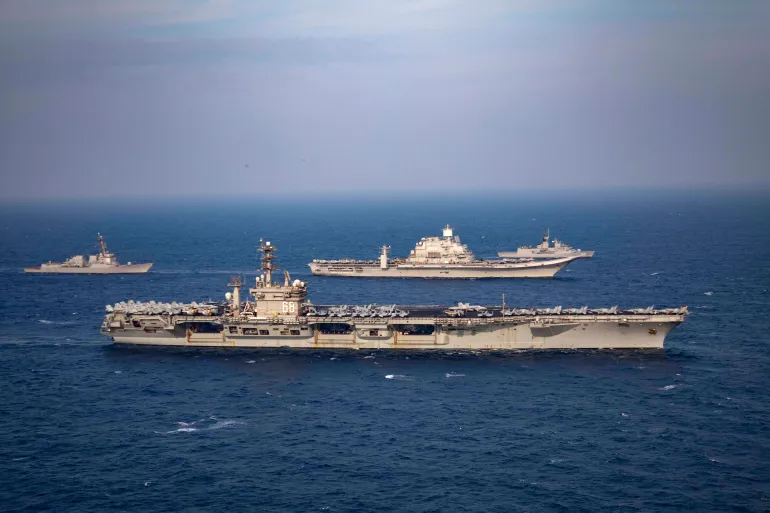India’s top political and military leadership has increasingly adopted a maritime-forward posture, raising concerns in the region about the potential for escalatory maneuvers at sea. Prime Minister Narendra Modi recently praised the Indian Navy during a visit aboard INS Vikrant, describing it as the “guardian of the Indian Ocean” and emphasizing the importance of maritime reach in India’s strategic calculus.
Naval “Opening” Framed as a Legitimate Option
This rhetorical positioning was further sharpened by India’s Chief of Naval Staff, who publicly stated, “If need arises, the opening will be done by the Navy.” The language, while seemingly abstract, effectively normalizes the concept of a naval “opening” as a viable first-strike option in future escalations, embedding it within India’s evolving military doctrine.
Sir Creek and Operation Sindoor: Expanding the Theatre
Defence Minister Rajnath Singh has also contributed to this narrative, repeatedly referencing the Sir Creek region and praising Operation Sindoor. These statements link land and creek flashpoints to a broader strategic framework that now explicitly includes littoral and shallow-sea theatres as potential zones of engagement.
Exercise Trishul: India’s Southern Command on Display
These declarations are not merely rhetorical. They are being operationalized through large-scale tri-service military exercises in India’s southern and western regions. The recent Exercise Trishul, a multi-domain war game spanning Gujarat, Rajasthan, and the Arabian Sea, featured amphibious landings, creek operations, and integrated maneuvers involving naval, air, and ground forces. The drills signal a high level of preparedness by India’s Southern Command for rapid deployment in maritime and coastal conflict scenarios.
Maritime Activity Suggests Full-Spectrum Readiness
Supporting these exercises is a surge in parallel maritime activity. NOTAMs (Notices to Airmen), large-scale amphibious taskings, and the post-Sindoor deployment of dozens of warships and aircraft suggest that these are not symbolic drills. Rather, they appear to be comprehensive rehearsals for potential real-world operations involving creek and sea-based engagements.
Pakistan Intercepts Operative Allegedly Coerced by RAW
Amid this backdrop, Pakistan’s security agencies intercepted a coerced operative — fisherman Ijaz Mallah — who was allegedly forced by India’s intelligence agency RAW to procure Pakistan Navy, Rangers, and Marines uniforms, along with name-tags, SIM cards, and local currency. The incident is significant, as it reveals the tactical tools required to stage a false-flag operation with plausible deniability.
Classic False Flag Formula: Intent, Rehearsal, Attribution Tools
Taken together, India’s public rhetoric about naval openings, the Southern Command’s amphibious rehearsals, and the procurement of Pakistani military identifiers form a textbook formula for a maritime false-flag operation: (a) telegraph intent, (b) rehearse the theatre, and (c) prepare attribution tools.
Creek Zones Offer Strategic Ambiguity
Creek and shallow-sea environments are particularly suited for such operations due to their inherent ambiguity. These areas involve small craft, amphibious insertions, and mixed civilian traffic, all of which complicate rapid forensic attribution. Limited access for independent observers further enhances the potential for confusion and misdirection. Exercise design and NOTAM footprints suggest that India has selected these complex geographies deliberately.
Operational Risk: Rapid Escalation Through Fabricated Incidents
The immediate risk lies in the possibility of a staged incident using Pakistani uniforms or vessels. Such an event could be quickly framed as an act of aggression by Pakistani irregulars or state-linked actors, triggering swift naval reprisals, temporary sea lane closures, and a cascade of military escalations. Politicized media narratives would likely follow, shaping public perception in favor of the instigating party.
Economic Fallout: Insurance, Trade, and Supply Chain Disruption
The downstream economic consequences of such an incident would be severe. Insurance underwriters would re-price risk across Arabian Sea routes, leading to spikes in war-risk premiums for tankers and cargo vessels. Shipping would be rerouted to longer, costlier passages, increasing freight rates and delivery times. The resulting supply-chain disruptions would ripple globally, raising fuel, commodity, and manufacturing costs — particularly in economies reliant on just-in-time logistics.
Diplomatic Complexity: Attribution Becomes Politically Charged
Diplomatically, India’s prior public statements about initiating naval action and the discovery of operatives with Pakistani identifiers would make immediate, impartial attribution politically difficult. This ambiguity increases the likelihood that any incident would escalate into a regional or even international crisis before neutral forensic assessments could be completed.
Pakistan’s Response: Evidence and Warning to the World
Pakistan’s interdiction of the Mallah operation — including the confiscation of uniforms, SIMs, and recorded confessions — removes a tactical asset and creates a documented evidentiary trail. This record should serve as a warning to international maritime authorities and the global community about the risks of misattribution and the potential for engineered escalation.
India’s Maritime Moves Demand Global Scrutiny
India’s assertive naval signaling, coupled with Southern Command rehearsals and the exposure of covert procurement efforts, collectively establish the preconditions for a maritime false-flag operation. Such an event would not remain a bilateral issue. It would threaten international shipping lanes, destabilize global insurance markets, and risk drawing third-party navies into a rapidly escalating crisis in the Indian Ocean region.
For climate-related stories, visit: The Green Post






